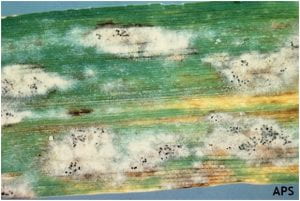Bob Mulrooney, Extension Plant Pathologist; bobmul@udel.edu
Wheat
The first disease of the season on wheat is usually powdery mildew. In general, powdery mildew has not been a problem for several years. Once wheat reaches jointing (Growth Stage 6) it should be scouted regularly for powdery mildew. As always, planting the highest yielding resistant varieties is the best control strategy, but if mildew threatens to rob yields later, fungicide control is the best control measure. Tilt, Propimax EC, Stratego, Quilt, Proline, and Caramba (the new Group 3 triazole from BASF) are suggested for control when and if fungicides are needed. These fungicides are also very effective for control of tan spot and Septoria leaf spot and glume blotch. It is common for powdery mildew to infect the lowest leaves and remain there for some time. The critical time to scout for powdery mildew is GS 8-10 (when the last leaf just appears until head emergence) to determine if fungicides are needed.
Barley
We have had reports of increasing amounts of powdery mildew on barley. ‘Thoroughbred’ looks to be the most susceptible variety but others should be scouted as well. Regionally we have no data to evaluate fungicides for control of barley diseases because barley rarely needs to be sprayed for diseases and the cost has been prohibitive. Times have changed, and if the heads are emerging and the top two leaves are infected there may be some benefit to controlling powdery mildew on a susceptible variety such as ‘Thoroughbred’ if the weather continues to favor powdery mildew. Stratego, Tilt, Quilt (10.5 – 14.0 oz/A) would be suggested for control if necessary. A beneficial non-target effect will be brighter straw if straw is being baled.
Powdery mildew on barley.
Soybean Cyst Nematode
It is still not too late to check for soybean cyst nematode, especially if susceptible soybeans are going to be planted. Soil test bags with the submission form can be purchased at the Extension offices. If you have a fax machine and need results quickly, test results can be sent via FAX if you provide the number on the Nematode Assay Information Sheet. This information sheet can be found on the web at the Plant Clinic Website http://ag.udel.edu/plantclinic .
